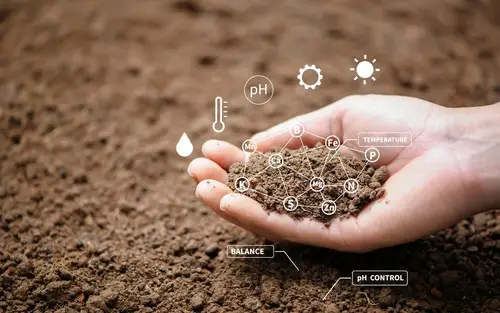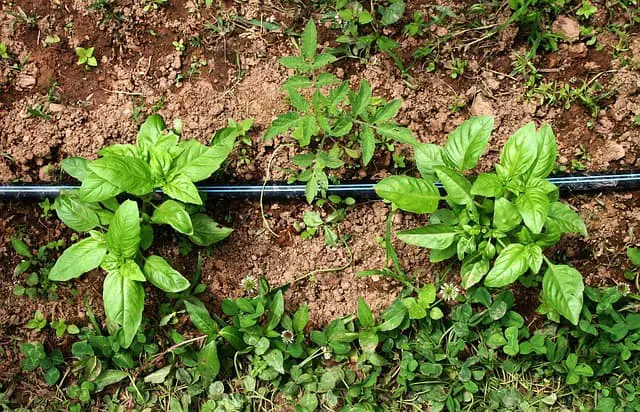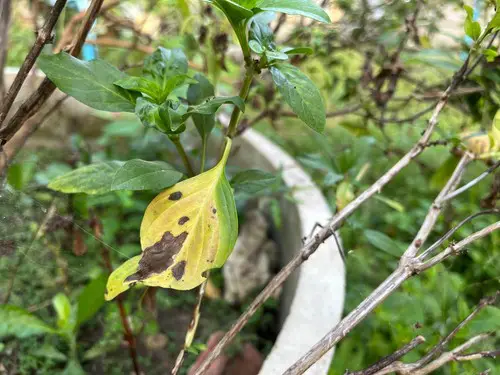Basil is a popular herb used in a variety of dishes, including pasta, salads, and sauces. However, if you’ve notice basil leaves with brown spots, you may be wondering if it’s still safe to eat. In this article, we’ll explore the causes of brown spots on basil leaves, how to treat and prevent them, and whether or not it’s safe to consume basil with brown spots.
Understanding basil leaves is essential in identifying brown spots and their effects on the plant. Basil leaves are generally green and smooth, but they can develop brown spots due to various reasons, including fungal or bacterial infections, nutrient deficiencies, or pests.
These brown spots can affect the plant’s overall health and may reduce its yield, making it essential to address the issue promptly.
Identifying brown spots on basil leaves is crucial in treating and preventing them. Once you’ve identified the cause of the brown spots, you can take the necessary steps to treat and prevent them. Proper watering habits, adequate plant spacing, and safe seeds are some of the measures you can take to prevent brown spots from appearing on your basil leaves.
Key Takeaways
- Brown spots on basil leaves can be caused by fungal or bacterial infections, nutrient deficiencies, or pests.
- Proper watering habits, adequate plant spacing, and safe seeds are some of the measures you can take to prevent brown spots on basil leaves.
- Basil with brown spots is safe to eat as long as it’s not diseased or sprayed with pesticides.
Check out these other related posts:
- Basil Brown Spots on Leaves: Causes, Solutions & Best Care Tips
- Azalea Yellow Leaves Brown Spots:
- Avocado Plant Brown Spots on Leaves
Understanding Basil Leaves

Basil is a popular herb that is widely used in various cuisines around the world. It is a member of the mint family and is known for its fragrant, sweet, and slightly peppery flavor. Fresh basil leaves are commonly used in salads, soups, stews, sauces, and as a garnish for various dishes.
The Role of Basil in Cuisine
Basil plays a crucial role in many cuisines, adding a distinct flavor and aroma to dishes. It is a key ingredient in many Italian recipes, particularly in pesto sauce, which is made by blending fresh basil leaves, garlic, pine nuts, Parmesan cheese, and olive oil. Basil is also used in Thai cuisine, where it is added to soups, curries, and stir-fries.
Apart from its culinary uses, basil is also known for its medicinal properties. It is believed to have anti-inflammatory, antioxidant, and antibacterial properties, making it a popular natural remedy for various ailments.
When it comes to using basil leaves, it is important to note that they are best used fresh. Dried basil leaves lose their flavor and aroma over time, so it is recommended to use fresh basil whenever possible. Fresh basil leaves can be stored in the refrigerator for a few days, but they tend to wilt quickly, so it is best to use them as soon as possible.
Identifying Brown Spots on Basil Leaves
Basil leaves with brown spots are not uncommon. While they are not harmful to consume, they can be unsightly and indicate deeper issues in your herb garden. Here are some possible causes of brown spots on basil leaves:
1. Fungal Infections
Brown spots on basil leaves can be a sign of fungal infections, such as Fusarium wilt caused by the fungus Fusarium oxysporum, or downy mildew caused by the oomycete Peronospora belbaharii.
Symptoms of downy mildew include yellowing, browning, and curling of leaves, with the presence of grey or purplish fuzz on the bottoms of the leaves. Fungal infections can persist in the soil for years and can be difficult to treat.
2. Bacterial Infections
Bacterial infections can also cause brown spots on basil leaves, such as bacterial leaf spot caused by Pseudomonas cichorii. The spots are usually angular and water-soaked, with a yellow halo around them. Bacterial infections can spread quickly and cause significant damage to the plant.
3. Pest Damage

Pests such as aphids and slugs can eat holes in basil leaves, causing brown spots. Pest damage is often accompanied by other symptoms such as wilting and yellowing of leaves.
4. Environmental Factors
Brown spots on basil leaves can also be caused by environmental factors such as sunburn, frost damage, overhead watering, and moist conditions. Basil plants are sensitive to extreme temperatures, wind, and humidity, which can cause stress and lead to brown spots on the leaves.
Effects of Brown Spots on Basil
Basil is a popular herb used in various recipes, including sauces, soups, stews, and garnishes. However, brown spots on basil leaves can be a cause of concern for many people. In this section, we will discuss the effects of brown spots on basil and whether it is safe to eat.
Impact on Taste
Brown spots on basil leaves can affect the taste of the herb. The flavor of basil comes from its essential oils, which are concentrated in the leaves. When the leaves start to brown, the essential oils can break down, resulting in a change in flavor. The taste of basil with brown spots can be bitter or metallic, which can ruin the dish’s overall flavor.
Use
Basil with brown spots can still be used in recipes, but it is essential to inspect the herb carefully. If the brown spots are dry and do not have a slimy texture or moldy smell, the basil is safe to use. However, if the spots are slimy, moldy, or have a foul smell, the basil has gone bad and should be discarded.
If you are using basil with brown spots in a recipe, it is best to remove the affected leaves and use the remaining leaves. You can also use the basil with brown spots to make pesto or other sauces, as the browning will not affect the taste as much.
Treatment and Prevention of Brown Spots
Brown spots on basil leaves can be a sign of various issues such as fungal or bacterial infections, pests, or nutrient deficiencies. Here are some methods to treat and prevent brown spots on basil leaves:
1. Nutrient Management

One of the most common reasons for brown spots on basil leaves is a nutrient deficiency. To prevent this, it is essential to maintain a well-balanced nutrient profile in the soil. Basil requires a lot of nitrogen, so adding compost or nitrogen-rich fertilizers such as blood meal or fish emulsion can help.
It is also essential to ensure that the soil is well-drained and has a pH between 6 and 7.
2. Safe Seed Practices
Using infected seeds can also lead to brown spots on basil leaves. Therefore, it is crucial to use safe seeds to prevent the spread of diseases. It is recommended to buy seeds from reputable sources and avoid using seeds from infected plants.
Additionally, it is essential to maintain proper watering habits and adequate plant spacing to prevent the spread of diseases.
3. Fungicides and Neem Oil
If brown spots have already appeared on basil leaves, it is essential to act quickly to prevent the spread of the disease. Fungicides can be used to treat fungal infections, while neem oil can be used to treat bacterial infections. It is essential to follow the instructions on the packaging and apply the fungicide or neem oil as recommended.
4. Pruning and Proper Watering Habits
Pruning can also help prevent the spread of diseases. Removing infected leaves and stems can prevent the disease from spreading to other parts of the plant. Additionally, proper watering habits can help prevent the spread of diseases.
It is essential to water the basil plant at soil level and avoid getting water on the leaves, which can promote the growth of fungi and bacteria.
5. Growing Indoors
Growing basil indoors can also help prevent the spread of diseases. Indoor plants are less likely to be affected by pests and diseases, and it is easier to control the environment. Additionally, growing basil in a container with well-drained soil can help prevent the spread of diseases.
Is It Safe to Eat Basil with Brown Spots?
Basil is a popular herb used in many dishes, but what happens when brown spots appear on its leaves? Is it still safe to eat? The short answer is yes, it is safe to eat basil with brown spots as long as the leaves are not diseased or sprayed with any pesticides.
Brown spots on basil leaves can occur due to various reasons, including temperature fluctuations, sunburn, nutrient deficiencies, pest damage, or fungal infections. However, the brown spots themselves are not harmful and do not affect the taste or nutritional value of the herb.
It is important to note that if the brown spots are accompanied by fuzzy white or gray growth on the leaves, it may indicate a fungal infection. In such cases, it is recommended to discard the affected leaves and avoid consuming the herb until the issue is resolved.
In general, it is always a good idea to inspect the basil leaves before using them in your dishes. If the leaves are discolored, slimy, or have a foul odor, it is best to discard them. However, if the leaves with brown spots are still firm and have a fresh aroma, they are safe to use.
To summarize, while brown spots on basil leaves may not be aesthetically pleasing, they do not pose any health risks and are safe to eat. As long as the leaves are not diseased or sprayed with any harmful chemicals, you can still enjoy the flavor and nutritional benefits of this herb.
Final Thoughts

When it comes to brown spots on basil leaves, it can be difficult to determine if the herb is still safe to eat. However, as long as the brown spots are not accompanied by any other signs of mold or decay, the basil should still be safe to consume.
It is important to note that the brown spots on basil leaves may be indicative of a larger issue with the plant. For example, if the stems of the basil plant are also brown and wilted, it may be suffering from a fungal disease like Fusarium Wilt. In this case, it is recommended to dispose of the plant and start fresh with new basil.
To prevent brown spots on basil leaves, it is important to keep the plant in a location with proper air circulation and spacing. Additionally, it is recommended to avoid leaving basil crop residue in the garden or greenhouse to overwinter.
Final Thoughts
In summary, while brown spots on basil leaves may not be aesthetically pleasing, they do not necessarily mean that the herb is unsafe to eat. As long as the spots are not accompanied by any other signs of mold or decay, the basil should still be safe to consume.
However, it is important to address any larger issues with the plant to prevent future brown spots from appearing.
Frequently Asked Questions
Should I cut off brown basil leaves?
Yes, it is recommended to cut off brown basil leaves. The brown spots on the leaves can be an indication of a fungal or bacterial disease that can spread to the rest of the plant. By removing the affected leaves, you can prevent the spread of the disease and promote healthy growth.
How to treat brown spots on basil leaves?
Treatment for brown spots on basil leaves depends on the cause of the spots. If the spots are caused by a fungal or bacterial disease, you can treat them with a fungicide or bactericide. However, prevention is key, so make sure to keep the plant in a well-ventilated area, avoid over-watering, and remove any affected leaves promptly.
Can I use brown basil leaves in pesto?
While you can technically use brown basil leaves in pesto, it is not recommended. The brown spots can affect the flavor and texture of the pesto, and the leaves may not be as fresh and healthy as green leaves. It is best to use fresh, green basil leaves for the best flavor and quality.
Is it safe to eat basil with bacterial leaf spot?
Bacterial leaf spot on basil is caused by the bacteria Pseudomonas cichorii and can cause brown spots on the leaves. While it is not harmful to consume basil with bacterial leaf spot, it is not recommended as the affected leaves may have a bitter taste and affect the flavor of your dish.
Can you eat basil with fungus?
It is not recommended to eat basil with fungus as it can be harmful to your health. Fungal infections on basil can cause brown spots on the leaves and affect the flavor and quality of the herb. It is best to remove any affected leaves and avoid consuming them.
What to do about brown spots on basil?
If you notice brown spots on your basil leaves, it is important to take action to prevent the spread of disease. Cut off any affected leaves, and treat the plant with a fungicide or bactericide if necessary.
Make sure to keep the plant in a well-ventilated area, avoid over-watering, and remove any affected leaves promptly.

Hey, I’m Lisa and I’ve been an avid gardener for over 30 years. I love writing, talking and living in the garden! Feel free to connect with me on my socials below

